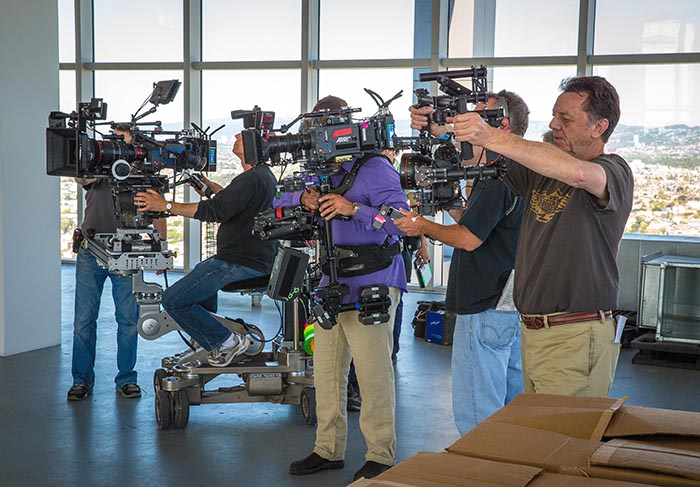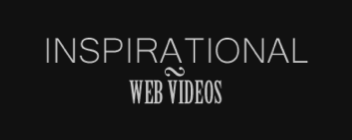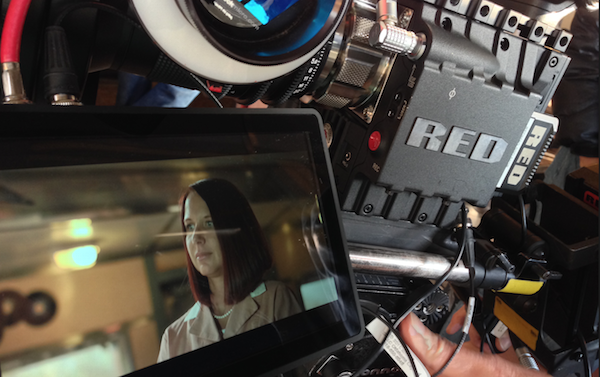If you want to stand out in the filmmaking crowd, focus on the evolution of your CRAFT – not the TOOLS.

(Source Article)
Many of you may have noticed how somewhat “quiet” this blog has been this year. I thought I would share some of the reasons why, because I think that they have far reaching implications far beyond this little blog…
The simple excuse is that I broke my arm this January, and that I couldn’t write for several months. I also changed my media consumption habits (both as a result of the injury, as well as to general social media trends) to newer, more immediate and often shorter form ways of communicating, such as Twitter, Instagram or Storehouse. I read fewer blogs today and spend more time on my iPhone – as statistically many of us are doing.
But the real reason is in fact more tied to my evolution as a director since the Canon 5D MKII came out in 2008, as well as to the general changes in the filmmaking landscape overall.
Side note: Can you believe it’s been 6 years since that terrible little cologne commercial Reverie came out – shot with the first 1080p DSLR?!?
On a base level, this blog was born out of talking about TECHNOLOGY. Gadgets, new cameras, lenses, software and MoVIs!
I, like many others, was pulled into the DSLR movement by a magical force called ACCESS.
The DSLRs were affordable, lightweight, and produced amazing quality imagery. These tools for better and for worse (depending on where you stood and now stand) leveled the playing field, at least in terms of access to the high TECHNICAL IMAGE QUALITY creation TOOLS. (Notice that I’m not talking about the quality of the CONTENT or STORY the technology produces.)
Directing any and all MOTION content has always come down to one’s ability to tell a STORY adeptly. That hasn’t changed since the first cave drawings and never will. You need to know what makes a good story, how to tell it best, and what tools to use. They don’t (yet) sell you that in a box, that can be delivered by drone to your doorstep.
Over the past decade or so, we’ve witnessed a revolution in terms of the technical quality of the imagery the average camera produces. Just as importantly, the tools the average person has access to today, are exponentially better than those that a high end professional had access to less than a decade ago: and at a fraction of the price.
On a technical level at least, I can take a significantly better looking image with my iPhone today, than I could with a $22K digital camera in 1999. A teenager can share an image so much more easily with millions of people, for free, and do so so much more quickly, then I could as a photojournalist at The New York Times less than a decade ago… and that’s amazing, and at times of course: scary.
Both the QUALITY and COST have been evened out within our business: and historically that’s relatively rare.
The question we now must all ask ourselves as creative professionals is: how do we survive within this new landscape? (especially in one that is moving so fast!)
One of the main reasons I’ve been less vocal on this blog in fact, is that I’ve been trying to figure this all out for myself. How do I stay ahead of the ball that is crushing so many established agencies, productions companies, and directors/artists? How do we stay ahead of the curve? What is the "secret" to success going forward when everything changes so quickly?
We have become a culture of instant gratification: we know what we want, and we want it NOW… The average attention span has waned significantly as well. Simply put: we want fast solutions to big problems and are willing to pay to get it. So what is the best thing we can BUY to become great filmmakers? What is the best CAMERA and LENS I can buy NOW so many of us ask?
Well then answer has been around for awhile. It’s nothing new: it’s call SKILL and KNOWLEDGE OF (and respect of) CRAFT.
Am I an idealist? SURE – but I also think I’m quite grounded in reality. And I think that as the cameras become ubiquitous, as everyone gravitates towards the same tools, the playing field will truly become leveled, and ironically we’ll discover that only our true differentiator in time will become the author’s understanding of how they can best put those tools into use. That is what will ultimately set us apart from one another. The exponentially increasing camera technology will indeed its own worst enemy.
Therefore, the more I think of the changes that happen within this crazy field, the more I see that CRAFT will natural find its way back in the driver’s seat sooner rather than later. And that should be comforting to some.
The business and distribution models, and how those will evolve, is still a bit more up in the air for now. That’s for another blog post…
If EVERYONE has ACCESS to the same technology, and can produce high quality imagery affordably, the only thing we can’t “buy” off a shelf, is the knowledge of how to use this incredible technology to better tell stories. We can purchase educational material, but it still takes time as well as a healthy dose of trial and error to master anything worth mastering.
Many of us have witnessed this explosion of high tech tools we can apply to storytelling: from time lapse, HDR, Hyperlapse, high resolutions and dynamic ranges, stabilization platforms and software. Just as quickly: many of us have come to realize how DIFFICULT THE ART OF TELLING STORIES can be.
Personally I am working on making my first film. I am not stressing about any technical aspect of the film, the funding of it, nor the distribution of the final film. I am however keenly focused on finding the best story to tell, and making sure that I very carefully focus on HOW I will eventually tell it, once I do find it.
The irony in all of this, is that digital can be said to have diminished the perceived value of CRAFT or of a CRAFTSPERSON since we began this decade.
For example: why hire a Director of Photography to expertly judge how the light and lens will expose a scene on celluloid film, when you can use a digital camera and see for yourself immediately and interactively on a monitor? Keep in mind that when we were shooting film, the Director of Photography on set was likely one of the few people who knew how what you were seeing with your naked eye would actually look once processed on the film and projected… and that meant that we were more willing to let her/him to their job without interference…
In fact, why hire anyone to do anything when you can do it yourself? That’s a valid question: unless you realize that maybe you can’t… Maybe it was much more than that in the first place. Perhaps you realize that you were also hiring that Director of Photography for his or her expert knowledge of how to lens a frame, or how to move the camera let alone light the scene… for the valuable experience they brought to bear to your project.
As many of us have witnessed over the past decade, we’ve enter the age of the “one person band” or the “PREDITOR” (Producer – Director – Editor all in one.)
The only thing that keeps me up at night these days, is that we seem to have entered the age of “Good Enough.”
These days it seems that there are far too many clients who are willing to settle for good enough, especially if it’s significantly less expensive than “excellence” or “groundbreaking…” This is in part due to the reality that we’re all bombarded by SO MUCH CONTENT, for a much shorter period of time now. Clients now need to create a dozen shorter pieces that will run for a few weeks or month each (perhaps concurrently,) as opposed to one that will run for a year or more. That changes things of course… and you DO wonder: is "Good Enough," good enough?
We are in a decade where shortcuts are all too popular… ironically these ‘shortcuts’ got us here in the first place if you look back at what caused the banking / stock market crash that thrust us into the past few years of smaller budgets and a more conservative approach to risk taking… but I digress.
The point is that I think, or more accurately I hope, that we’re going to turn the corner over the next few years – and ironically come full circle.
The biggest change we will see, in my opinion, is that people will start to focus less on HOW we move the camera for example, and more on the WHY we move the camera in the first place. Just because you can do a one shot wonder on a MoVI on a shot that last 40+ minutes, doesn’t mean you should, nor that it is necessarily to effectively tell a story for example.
Personally, I’ve undergone a big transformation myself as I evolved into directing bigger and more complex projects myself: I realized that I could rely on other people to figure out the technical solutions to my creative ideas… but that as a director no one could help me if I myself did not have a clear creative idea or vision to communicate to them in the first place…
I’ve also been busier as a result and naturally have had less time to write as often on this blog. But I think that’s expected. Once I move forward with a film, this blog will come back to life – at least that’s been my plan all along.
I also realized that a director’s role was to master the art of WHY certain techniques or tools could elevate the way a story was told, and not to worry as much about HOW to put these techniques into effect practically (although that never hurts to know of course.)
There are of course many different types of filmmakers out there: some that work alone, others that work with large teams, and everyone in between. As we move forward we will continue to see a natural erosion of the range of tools and gadgets that both the small and big budget filmmakers have access to.
Technology is the ultimate equalizer.
Yet, at least until they can teach a camera or piece of software what type of move is best, the cadence of a scene, or type of direction that is given to an actor… that knowledge will become more and more important as the technical barriers continue to disappear.
And that’s why any artist / filmmaker going forward should focus less and less on technical specs, and more and more on craft.
The HOW will become more ubiquitous, and many will have access to almost the exact same tools ultimately – but the understanding of WHY we need those same tools to augment our storytelling is something we can’t yet buy.
Of course this new millennium is young… We might yet see an algorithm built into a GoPro some day that suggests to the user whether to take two stops forward or backwards when they frame up a shot… but I have to say that I’m optimistic that while business models, distribution models, and camera models continue to evolve: There will always be an appetite out there for a skilled storyteller. And won’t EVERYBODY be using the same algorithm anyway? Well at least at first… then do we "ugrade" to the better AI?
That is of course as long as we all have the discipline to exit this age of “good enough.” As the economy hopefully continues to improve, I trust that by definition we will gravitate back towards greater risk taking, and better products. Brands and companies need to go back to leading and taking more risk on every level, and in this case creatively.
In fact I think it’s already started. Have you noticed the increase in television quality over the past 2+ years and the quality of films this year and next?
Oh, and expect this blog to remain more active! Just expect me to write more about the CRAFT going forward, and less about the TOOLS I use going forward.
(Shameless plug, if you want to learn more about the CRAFT of directing, check out this material that I put together this year available to purchase & download, based on my favorite directors of all time and my favorite 100 films and how they use motion to better tell their stories.)
- - - - - - -
(Source Article)






 Post a Comment
Post a Comment





